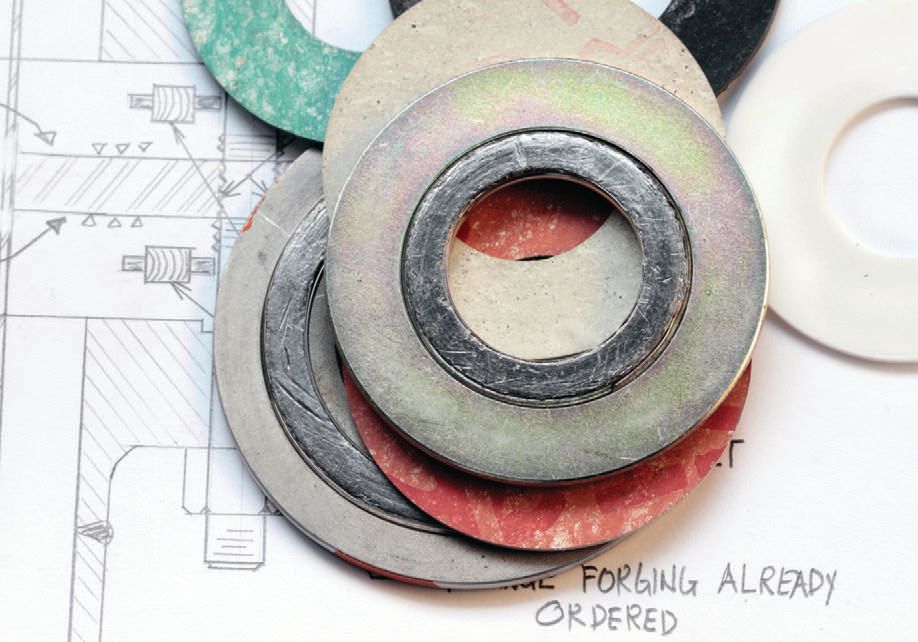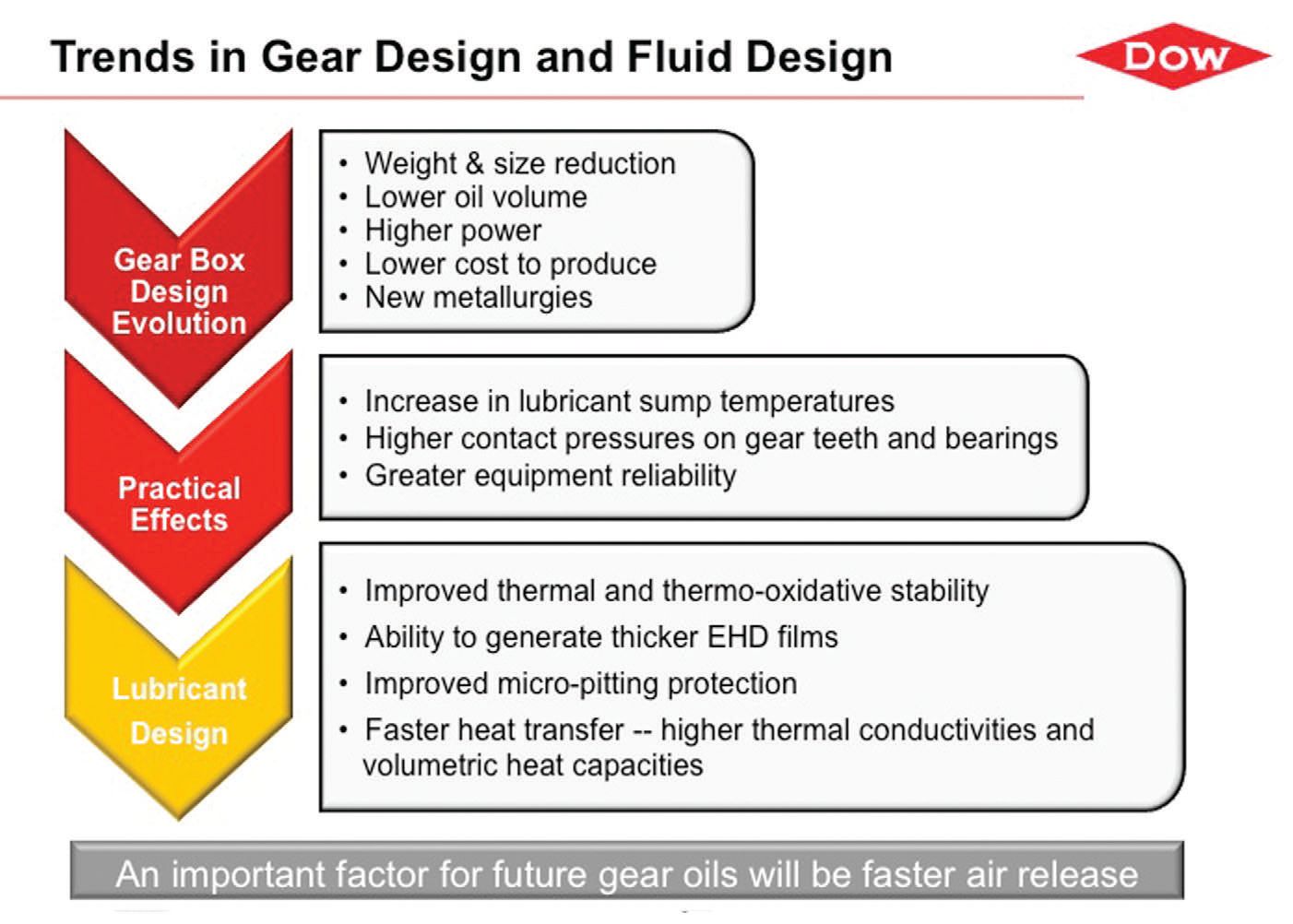The Dow Chemical Company
5 Reasons why Oil-Soluble Polyalkylene Glycol Consumption Doubled This Year
By Lisa Inoue, Strategic Marketing Manager, The Dow Chemical Company | TLT CMF Plus November 2013
Dow Chemistry Helps Solve Lubrication Challenges
What’s new about PAGs? Polyalkylene Glycols or “PAGs” have been around since the 1940s. Their chief use has been as primary base oils in synthetic compressor, gear and hydraulic oils, as well as performance additives in water-based fluids such as fire resistant hydraulic fluids. Today there are hundreds of PAGs in use, in applications ranging from metalworking fluids, gas and wind turbine lubricants, and ecofriendly non-sheening hydraulic fluids to military, agriculture, household cleaning and personal care products and pharmaceutical applications.


Despite being known for so long, PAG adoption continues to grow gradually with innovation in polymer design that leads to different tribology and rheology features. Lately oil-soluble PAGs are reinvigorating the industry. Unlike conventional PAGs, oil-soluble PAGs are miscible in hydrocarbon oils. This has two practical benefits. Firstly, equipment conversions from a hydrocarbon oil to an oil-soluble PAG are much simpler than converting to a PAG. Secondly, the excellent solubility of oil-soluble PAGs in hydrocarbon oils means they can be used as performance enhancing additives in API Group I-IV oils. Oil-soluble PAGs are available in 9 viscosity grades and can be used as a primary base oil, co-base oil or performance additive in many types of lubricant formulations. Here are five reasons why interest is growing rapidly.
Truly Impressive Deposit Control: Oil-soluble PAGs extend lubricant life and the reliability of expensive machinery through superior deposit control.
How: Oil-soluble PAGs are polar in nature, with the ability to solubilize hydrocarbon degradation products when used as deposit control additives. This helps prevent oxidation by-products from precipitating from fluids and leading to sludge and varnish formation.
Result: A leading commercially-available Group II based compressor oil was subjected to the ASTM D2893B oxidation test over an extended period. By comparison, the same oil was top treated with 10% oil-soluble PAG. The commercial oil showed evidence of significant deposits and darkening. The inclusion of oil-soluble PAG resulted in a much cleaner fluid with no visual evidence of deposits or fluid ageing.
Reduced Friction: Oil-soluble PAGs exhibit exceptional ability to minimize metal-to-metal frictional losses and increase energy-efficiency.
How: As a surface active polymer, oil-soluble PAGs exhibit film-forming properties when added to hydrocarbon oils. High surface activity can impart heightened energy-efficiency.
Result: In 2011, oil-soluble PAGs were adopted as components of engine oils and transmission fluids in racing cars, yielding superior power-boost and deposit-control. More details can be found at
www.dow.com/ucon, enter key words “24 Hours of Le Mans”.
Increased Hydrolytic Stability for Esters: Oil-soluble PAGs are more hydrolytically stable than natural and synthetic esters. Surprisingly they can help improve the hydrolytic stability of esters when added as co-base oils. This can extend fluid life.
How: In environments where moisture can enter the system, Esters are prone to hydrolysis, leading to acid generation and fluid degradation. In many European countries, and particularly Germany, vegetable oils are used in both stationary and mobile hydraulic systems. Oil-soluble PAGs are more stable than esters, and when added to ester compositions, can act like polymeric sponges that hold water within their polymeric matrix and render it less active, thus minimizing degradation of esters by hydrolysis.
Result: Oil-soluble PAGs are recommended as performance additives for upgrading and safeguarding fluids made with natural or synthetic esters.
Enhanced Elastomeric Protection and Seal Swell: It’s a little known fact that the right oil-soluble PAG will preserve sealing properties and counteract elastomer shrinkage due to the cracking, polymerizing and resinifying effects of certain hydrocarbon mineral oils and PAOs.
How: Specific grades of oil-soluble PAGs have intrinsic properties that swell some elastomers and seals, negating the seal shrinkage effect. They can also enhance additive solubility where it is otherwise limited in PAOs. By replacing an ester in a PAO, it is possible to minimize hydrolysis and extend fluid life.
Result: Some oil-soluble PAGs demonstrate similar seal-swell properties as esters, with the added benefit of hydrolytic stability that is absent in esters. In synthetic PAO gear oils, oil-soluble PAG may be a preferred choice over esters to gain excellent multi-functionality (seal-swell, deposit and friction control, additive solubility) in combination with hydrolytic stability at treat rates up to 20%.
 Air release values of commercially available gear and circulation oils
Better Equipment Protection, Increased Power Density:
Air release values of commercially available gear and circulation oils
Better Equipment Protection, Increased Power Density: Formulations containing oil-soluble PAGs as primary base oils provide outstanding air release properties with excellent oxidation stability across a broad range of viscosity grades.
How: Generally, lubricants can entrain as much as 10% of air by volume. Fast air release for hydraulic, turbine and gear oils is crucial. One unique property of oil-soluble PAGs is very fast air release. Fluids with poor air release cause cavitation, erosion, spongy controls, noise and faster ageing of fluid through oxidation.
Result: Better Equipment Protection. A comparison was made of air release times using ASTM D3427 for commercially available gear oils from two different suppliers (A and B) based on PAOs, conventional PAGs and oil-soluble PAGs in two popular viscosity grades (ISO-320 and ISO-460). The air release times for oil-soluble PAGs were much lower than other technologies at equivalent viscosity grades. This trend was further observed for oil-soluble PAGs versus PAOs, PAGs and mineral oils in viscosity grades ranging from ISO-68 to ISO-680.
Result: Increased Power Density. Lower air release time also has practical advantages in the design of smaller and lighter-weight reservoirs, sumps and gear boxes – resulting in lower capital and operating costs. As primary base oils in lubricants, oil-soluble PAGs exhibit fast air release properties, protecting machinery, supporting the trend to higher power densities and lowering the cost to manufacture equipment.
Result: Cold Climate Performance. Finally, the combination of high viscosity index, good low temperature properties, high oxidation stability and rapid air release make oil-soluble PAGs a good choice for equipment used in cold climates.


References
Matlock, P.L. and Clinton, N.A. (1993), “Polyalkylene glycols”, Shubkin R. (eds), Synthetic Lubricants and High Performance Functional Fluids, Marcel Dekker, pp. 101-123.
Greaves, M.R. (2013) “Polyalkylene glycols”, Rudnick, L.R. (eds), Synthetics, Mineral Oils and Bio-based Lubricants, Chapter 6, CRC Press.
Greaves, M.R., Van Voorst, R., Meertens, M., Khelidj N., Zaugg-Hoozemans E. (2012), “Performance properties of oil-soluble synthetic polyalkylene glycols”, Lubr. Sci., Vol. 24 No.6, pp. 251-262.